Last time on Mystery Album our mystery posh mystery photographer family looked out from a Stockholm City Hall corridor, next to the Golden Hall used for the Nobel Prize winner’s ball, towards the Riddarholmen where we shall continue our ‘ports of call’ tour of late 1920s Scandanavia.
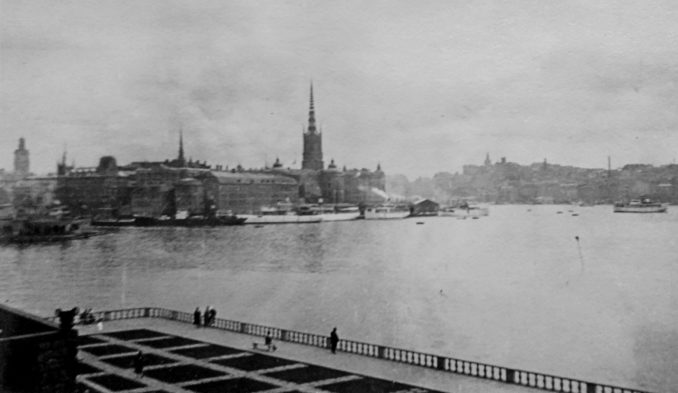
The distinctive spire is that of Riddarholmen Church, a former Greyfriars monastery and, until 1950, the burial place of Swedish monarchs. Named after the islet of Riddarholmen on which it sits, Gustav V was the last king to be interred there. His son, King Gustav VI Adolf (whose first wife was Queen Victoria’s granddaughter, Margaret of Connaught) was buried in a newer royal cemetery, the Kungliga Begravningsplatsen, next to Lake Brunnsviken in the Hagaparken district of the city. Another Swedish monarch resting away from the old Greyfriars church is Queen Christina of the House of Vasa who died in 1689.
Controversially, during her reign the daughter of King Gustavus Adolphus replaced notes and coins with lumps of copper. Some of the higher denominations weighed as much as three stones. Christina went on to bankrupt the country, convert to Catholicism, give up the throne to a cousin and retire to Rome.
She enjoyed the hospitality of five Popes but, despite her convert’s zeal, fell short of paying any of them for her stay. A grumpy Pope Alexander VII described her as, “A queen without a realm, a Christian without faith and a woman without shame.”
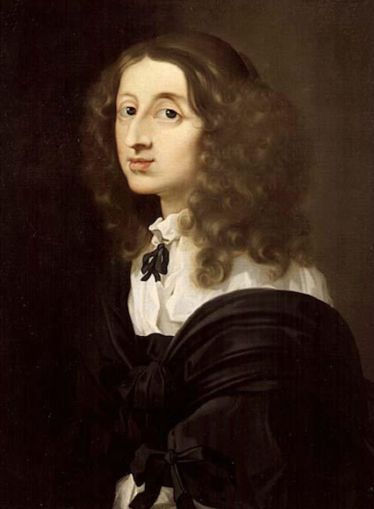
Queen Christina (1626-1689),
Sébastien Bourdon – Licence CC BY-SA 2.0
Despite this, she is buried in the Vatican Grotto, opposite Saint John Paul II and beside Queen Charlotte of Cyprus. Which reminds me, back in the day, anybody could wander into the grotto unchallenged (and for free) and this travelling gentleman often did, if only to escape a blazing afternoon heat unknown in my own Debatable Lands. At the time, I always wondered why, given the somewhat worldly behaviour of some of the company he was keeping, Callistus III had to be entombed down a long corridor all on his own. Upon the invention of the internet, when knowledge of all things became available to all men, I was too squeamish to look him up and remain so to this day.
Queen Christina was captured by her court painter, Montpelier born Frenchman Sébastien Bourdon. Note the poppy-eyed gaze similar to that of Moder Svea, or the Queen of Lake Mälar, depicted in the 15 million tile golden mosaic in the Gyllene Salon of City Hall.

The interior of Riddarholmen Church,
Albabos, – Licence CC BY-SA 3.0
The plain interior (above) of Riddarholmen Church shows two royal casks. To the right is the tomb of King Magnus III (Magnus Ladulås) who reigned between 1275 and 1290 and was a son of Birger Jarl whose gold sarcophagus we saw at the end of City Hall in a previous episode of Mystery Album.
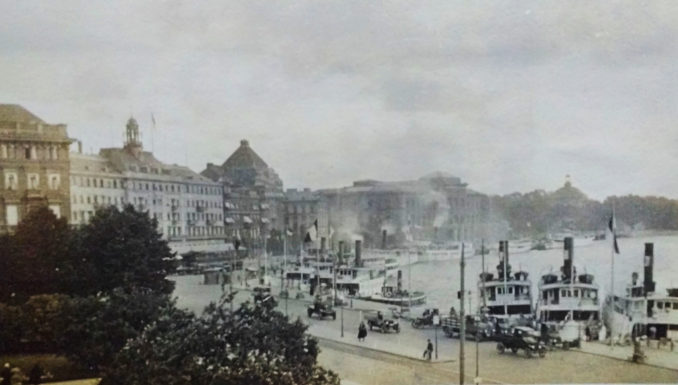
At first glance, you might think our next old photo is just a close up of Riddarholmen, our mystery photographer having walked around to that islet between exposures. But it isn’t. Reference to aerial photographs and mapping, regarding the building on the left-hand side with the little tower in the middle of the roof, drew me to the impressive limestone brick stucco facade of the 140-yard long art nouveau Strandvagen 1-5, also known as the Kvarteret Bodarna.
As for the dark building with the pitched roof to the left, it didn’t seem to be there anymore on Street View. Instead, there is a clear view of the Stockholm Royal Dramatic Theatre.
As other neighbouring buildings didn’t fit in either, one might assume some serious town planning in the intervening decades, but moving the lake would have been a big ask even for the industrious Swedes. Further investigation showed the art nouveau style to be common along Stockholm waterfronts.
A pleasant virtual wander around the Swedish capital, showed the large building with the little tower to be the Grand Hotel at Stromgatan. Now at the right place, rather than the building next door having been knocked down, it can be identified as the Palmeska Huset at No 2 Kungstradgardsgatan. The Kungstradgarden, or King’s Garden, in question being the tree-lined public park before the photographer.
Opened in 1874, once again in the art nouveau style, the Grand has over 300 rooms and suites of a five-star standard. Since 1901, Nobel prize laureates and their families have stayed there while the awards are conferred. At the moment, the Grand is owned by the local Wallenberg banking and industrialist family who are reputed to be worth a cool $300 billion.
Identification was helped by the dome on the right which eagle-eyed Puffins will recognise as being the Eric Ericsonhallen on Skeppsholmen island where the HSwMS Vanadis was moored.
Therefore, the building nearby with the pitched roof is the Burmanska Huset or Burma House, a residential building constructed between 1910 and 1912 in, as Puffins can already tell despite the splodgy photo, the late art style with added elements of incipient national romanticism. On either side, and difficult to make out, are an annexe to the Grand Hotel and the Lydmar Hotel respectively. The blocky building on the end of the row is the Nationalmuseum. All of these are still standing and nicely preserved.
Since the Nationalmuseum is periodically closed because of Covid, they offer Pythonesque sofa tours of the exhibits where odd things are described by strangely attractive eccentrics who can’t get their microphones to work. Yes you Pernilla Stalfelt.
Which begs the question, with the triangulation provided by the hall and the hotel, where exactly was the mystery photo taken from? Given we are above the height of the trees, perhaps from a fairground ride or monument within the immaculate Kungsträdgården public park? Maybe our photographer climbed the Karl XII statue or the Molins fountain?
Better than that. A stroll across the lakeside width of the park takes us to an impressive flight of steps, ideal for a photo. Better still, the stairs lead to the roof terrace restaurant of the Royal Swedish Opera House. No doubt open-aired in the late 1920s, perhaps our mystery posh family refreshed there while taking a snapshot as they did at the Bageriet Barrather in Stora Torgot in Gotland while capturing the Sankta Karin for posterity.
In the modern-day, the terrace is covered and not only survives as an eatery but as the impressive Michelin starred OperaKallaren. If the view is impressive, so are the prices. As usual, if you have to ask, you can’t afford it. Suffice it to say, if myself, Mrs AWS and the rest of the family enjoyed an eight-course set meal for seven with the recommended wine it would put us back just south of £4,000.
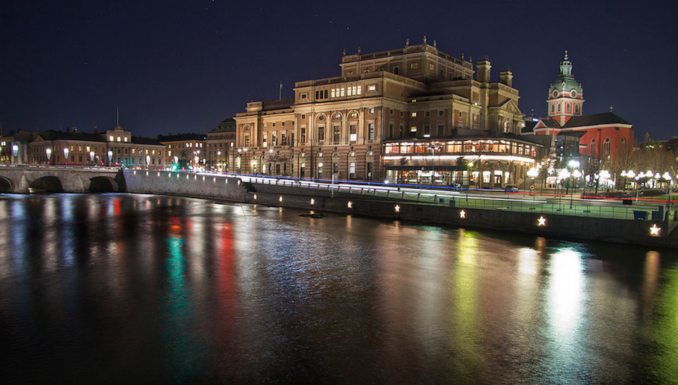
Stockholm Opera,
Jesus Del Toro Garcia – Licence CC BY-SA 2.0
As for the opera house itself, a glance at the modern photograph above, shows the OperaKallaren terrace on the right-hand side of the art nouveau Axel Johan Anderberg building, which was inaugurated in 1892 by old friend of Mystery Album, King Oscar II.
Talk of opera allows mention of another pop-eyed Swede, Greta Thunberg, whose mother Malena Ernmann was educated at the Royal Swedish Opera, as well as at the conservatory in Orleans, and later sang with the company. Her Rosina in their 1998 production of Barber of Seville was impressive. Her Kaja in Leif Segerstam’s production of Sven-David Sandström’s Staden was described as full and rich and not far behind Bartoli. More notably, and away from the répétiteurs, prompters and hundreds of yards of tulle, Ms Ernmann represented her country in the 2009 Eurovision Song Contest.
From the concrete chasm that is Moscow’s old Lenin Stadium, Melena belted out La Voix, confusingly in French, amassing a respectable 33 points and finishing 5th bottom, wedged between Malta’s full-figured Chiara Siracusa and Germany’s camp as a row of huts in mud Alex Swings, Oscar Sings.
Penned by herself in collaboration with Frederik Kempe and subsequently rising to 27th in the Belgian hit parade and 19th on the Finnish downloads chart, the rather naive lyrics don’t lend themselves to ponderous extrapolations regarding Swedish architecture but do strike a resonant note with this modest reviewer of old photographs.
I just wanna know,
I just wanna know,
tell me what you’re dreaming,
tell me what you’re dreaming.
Long-suffering readers will be aware that halfway between the present day and Mystery Album’s 1920s, your humble author enjoyed a life more interesting unknowingly treading in the footsteps of our mystery family.
Sure enough, as early middle age dawned, he dreamed of the higher latitudes once again and, as a gentleman of a certain social class and inclination is want to, felt obliged to re-trace his previously carefree younger self’s effortless route through life – accompanied by a wife, two tons of luggage and a stack of kids.
Unhindered by the limits of the mid-summer ice-free Baltic forced upon ‘port of call’ cruisers a near-century earlier, at the end of his fiftieth year he struck out by steel wheel and steel rail, dragging the family with him. A cynic might say it’s cheaper in the middle of winter. I say enjoy the Christmassy photo, perilously close to Santa’s factory at his busiest time of the year, as myself and the other Debatable Lands Worth-Sayings wish you a happy and spiritual Yuletide and a prosperous, safe and healthy New Year.
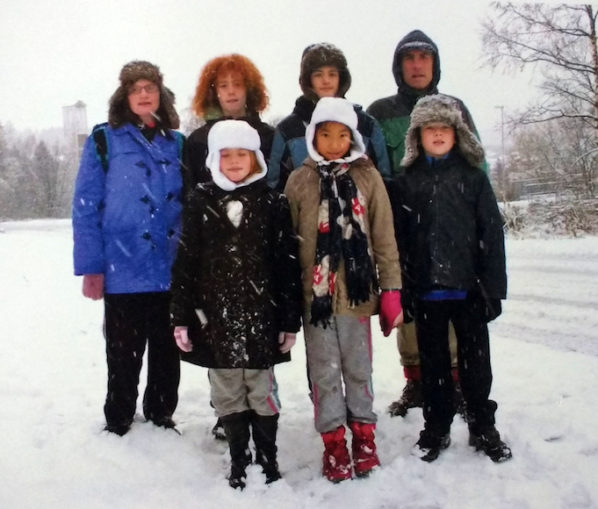
© Text and photographs unless captioned otherwise 2021 Always Worth Saying
The Goodnight Vienna Audio file
Audio Player



